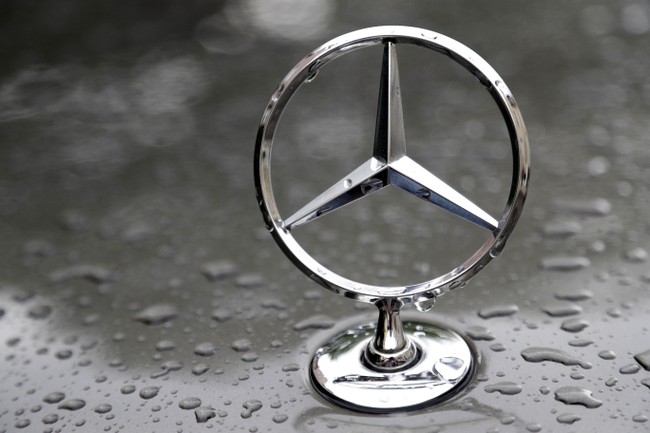Trying to Keep the ‘Ultimate Driving Machines’ On the Road
This post was originally published on this site

[Beege adds: I know, I KNOW – that’s BMW’s tagline. I was traumatized at the dentist’s first thing this morning. That’s my excuse, and I’m sticking with it.]
Advertisement
It’s been hard times for the auto industry, what with interest rates going up and consumer interest in the once Golden Calf-like electric vehicle sure thing going down.
It’s been especially tough to be a carmaker in Europe, where those EV sales numbers are mandates that come with healthy fines if they aren’t met. And all the while, you can’t sell what you need to sell because no one wants to buy them. To make matters worse, the European Union is about to hammer you financially as the Chinese eat your lunch and steal your cupcake.
If you’re a car company in Germany, you’ve got another set of homegrown problems on top of all that.
And now there’s Trump with a “T,” which is also the first letter in ‘T’ariffs.
The very thought has set auto manufacturers’ teeth on edge.
Volkswagen, the country’s synonymous vehicle manufacturer, is curling into a fetal ball, trying to avoid any more bad news or body blows. You can probably hear them squeaking, ‘Please don’t hurt me anymore‘ from here if you listen real close.
The entire European auto sector was pronounced to be in an ‘existential crisis’ just last month.
…Mandates and Green dreams still can’t change what people want and are willing to pay for, it seems.
European automotive suppliers are experiencing unprecedented turbulence as electric vehicle market uncertainties trigger a wave of dramatic workforce reductions. Major manufacturers are confronting a perfect storm of economic challenges that threaten the industry’s traditional foundations.
In a stark illustration of the sector’s volatility Robert Bosch, ZF Friedrichshafen, Continental and Schaeffler have collectively announced 54,000 job cuts in 2024. This figure represents a record number of redundancies surpassing those announced during the pandemic years of 2020 and 2021 combined according to the European Association of Automotive Suppliers (CLEPA).
Advertisement
The Grande Dame of German auto engineering, Mercedes Benz, has also had a rough go of it this past year and EVs were a good part of it. The company is warning that 2025 is going to be disappointing.
“Profits at the company’s car division dropped 41 per cent, while net profits fell 28 per cent to €10.4bn last year. Revenues dropped 5 per cent to €146bn.”
Mercedes-Benz warns 2025 profits will be ‘significantly’ lower – https://t.co/wgZXZnep3f
— WP 🇩🇪🇺🇸🇬🇷🇧🇪🇫🇷🇦🇹🇨🇿🇵🇱🇬🇧 (@WPipperger) February 20, 2025
And they are going to cut auto production in Germany. How’s that for an announcement three days before national elections?
Mercedes-Benz Group is cutting production capacity in Germany and moving some output to low-cost countries as it grapples with fierce competition and uneven demand in the global auto market.
The automaker said it plans to cut production costs by 10 percent through 2027 and will also work with suppliers to reduce material costs. Global prices for everything from chemical coatings to metals have risen in recent years.
Mercedes’ operating earnings slumped 30 percent last year, the automaker said on Feb. 20. Its automotive margin dropped to 8.1 percent, below the previous year’s 12.6 percent. The car division had a 40 percent slump in 2024 earnings as sales in the key Chinese and German markets took a battering.
Mercedes expects its automotive margin to drop to as low as 6 percent this year. After pledging to boost margins to a minimum of 8 percent less than three years ago, the new guidance marks a blow to Mercedes’ strategy of shifting upmarket to secure higher returns.
The production cuts are interesting, as they won’t be closing any factories in Germany, which has to come as a relief to the mainstream candidates running. But they will be moving production out of Germany to take advantage of cheaper labor costs and protect themselves from those Trump tariffs if they come to pass. So Hungary will score for their affordable wage structure – the company will save up to 70% in labor costs over the German unions – and another vehicle line will get shifted to the plant in Alabama, US of A. Tariff-proof, although the company denies the potential tariffs played any part in the decision.
Advertisement
OKAY
…Mercedes will reduce the capacity of its German plants to about 900,000 cars from around one million. There are no plans to close plants in Germany but jobs will be cut through natural attrition.
Kallenius would not say how many jobs could be affected in Germany.
Mercedes plans to shift production of one of its compact cars from Germany to its plant in Hungary, where costs are 70 percent lower, CFO Harald Wilhelm said.
It will also outsource areas from finance and human resources to procurement, he said.
To shield itself from tariffs and trade tensions, the carmaker will increase the number of cars produced within the market in which they will be sold from 60 percent to 70 percent globally, with a particular focus on China and the U.S.
The U.S. factory, in Vance, Alabama, is likely to get another “core” model, meaning a C- or E-Class vehicle, Kallenius said. The light truck factory builds the GLE, GLE Coupe and GLS, including EV variants.
According to a supply chain source, Mercedes could begin building GLC crossovers in the U.S. in the second quarter of 2027. The source told Automotive News GLC volumes could hit 50,000 vehicles in the first full manufacturing year.
Tariffs are a serious threat to a shaky European bottom line. At Mercedes, the CEO is saying the Trump tariffs would cost them a billion a year.
🇩🇪 German automakers are about to get hit with the next round of Trump tariffs. Biggest impact is expected on Volkswagen (80% of US sales are imported), Mercedes Benz (63%), BMW (52%). Scope, rates and impact on cars produced under the free trade agreement are unclear pic.twitter.com/kFvkgON2zL
— Nikolay Kolarov, CFA (@libertniko) February 15, 2025
Advertisement
Interestingly enough, that same Vance, AL plant was the scene last year of a fiercely contested labor fight over unionizing the plant, with all sorts of ugly accusations of skullduggery and malfeasance flying back and forth between Shawn Fain’s United Autoworkers (UAW) and Mercedes management.
It was nip and tuck and anyone’s guess, but in the end, plant workers voted to sent the UAW packing.
Most grievously affected, @BernieSanders .
— MarkWhittington (@MarkWhittington) May 17, 2024
As far as specific vehicle production plans go, Mercedes is going back to their roots – focusing on internal combustion engines (ICE) and elegant, expensive cars.
…Mercedes also said it will launch more gasoline and diesel cars than battery-electric cars in its new product range in a bid to revive margins.
The company will release 19 new combustion engine models and 17 battery-electric cars by the end of 2027, in a sign of a renewed focus on its combustion engine offering after its BEV sales collapsed by a quarter last year.
Most of the new models will be in its top-end price tier, showing that the carmaker is still committed to its strategy of selling a lower volume of higher-margin vehicles, despite some investors and labor representatives expressing concern in recent months that the strategy had failed.
If I might be so bold, another thing Mercedes could consider is to stop making such ugly, junky-ass cars. Hubs has a 2002 E430 we bought used (that we also desperately need to get back on the road), and he just can’t turn loose of it.
Why?
It’s a beautiful car. It’s everything the Mercedes you might have dreamt about one day buying and we lucked into it.
Advertisement
Every Mercedes we’ve looked at since has looked more unattractive and cheaper (!) with each new model year, and there are endless complaints about the quality issues. Our experience exactly mirrors what a fellow wrote in a letter about the company’s fall from customer grace in the hands of Swedish-German Mercedes CEO Sten Ola Källenius. He berates them for chasing ‘ostentation’ over the company’s heritage of quality and design.
I just read it, and I’ll bet it’s a good bit of their sales slump.
this letter to the editor summarizes Mercedes’s misery under Källenius:
The letter criticizes the current direction of Mercedes-Benz under Ola Källenius, arguing that it strays from the traditional “Swabian” values of modesty and quality. The author laments the shift toward… pic.twitter.com/PukWuyRfoj
— stekkerauto 🚗⚡️ (@stekkerauto) February 20, 2025
…The letter criticizes the current direction of Mercedes-Benz under Ola Källenius, arguing that it strays from the traditional “Swabian” values of modesty and quality. The author laments the shift toward excessive luxury and ostentation, such as oversized SUVs and overly elaborate designs, which he sees as incompatible with the company’s heritage. He praises the simpler, more functional designs of past eras, like those under designer Bruno Sacco, and calls for a return to a more balanced model lineup focused on quality rather than extravagance.
Full text: Swabian Gene
Regarding “Luxury Reloaded” (F.A.Z. from February 15): There is a Swabian gene. If one were to define it, “the Daimler,” as people in Stuttgart call Mercedes-Benz, is part of this gene. It’s a significant part that has ensured prosperity in the region for over a century. The current CEO Ola Källenius is not part of this genetic makeup. He has not understood that hubris is not a Swabian trait. In Sindelfingen, we have always built wonderful and even expensive cars and have impressed and inspired the world with our achievements in Swabian modesty. Then came the boasting with “the best or nothing.” With Källenius came the ostentation.
Now we get the bill: E-SUVs that look like small trucks, AMG versions with Rambo grilles, an oversized luxury sedan with a weird name, and an S-Class with side windows so slanted and an A-pillar so steeply inclined that only a hunched posture allows entry. Is this luxury? Just now, the highly talented designer Bruno Sacco passed away. If only there were such talents again at Daimler. And a model range that is clear and focuses on the economically significant mid-size segment. That was always Sindelfingen’s hallmark. Luxury could then be afforded when one was asked for it—and it was requested. Delivery times were the secret
Advertisement
Herr Bonz from Böblingen nails what ails them.
The EV situation is an easy excuse, but it’s not the whole shebang. Mercedes has an image problem which is a real problem for a company whose reputation is built on their image. Once upon a time, you saw that symbol, and your brain said ‘German engineering’ or, more hilariously, like the old commercial, ‘qvick and qviet.’
Now, it does look as if they have a good start on the road back to classic. Mercedes designers have already ‘refreshed’ the ‘S’ class, and I have to say, it looks schweet, weird, fuzzy headrest notwithstanding.
More than spectacular: the #SClass.
📷 sebastiankubatz (IG) for #MBcreator#MercedesBenz #MANUFAKTUR pic.twitter.com/TFnGilrSLw
— Mercedes-Benz (@MercedesBenz) February 20, 2025
If they capture more of that timeless quality, get their engineering ducks back in a row, and navigate the EU-mandated EV hump, maybe there will be brighter driving days ahead.
If their impish sense of humor is restored…
…we’ll know things are going well and the confidence level is high.
